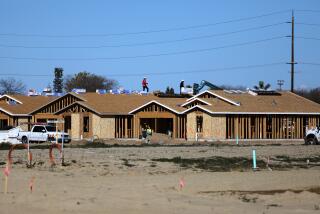Single-Family Housing Starts Climb Sharply
- Share via
WASHINGTON — Construction of single-family homes rose sharply in March for the second consecutive month, the government said Tuesday, offering evidence of a healthy building season this spring.
However, a steep decline in apartment construction held the overall level of housing starts to a seasonally adjusted annual rate of 1.54 million units in March, a modest 1.9% increase over the previous month, the Commerce Department said.
The strength in starts last month came in construction of single-family housing, which rose 7.1% to a seasonally adjusted annual rate of 1.18 million units after an even stronger 8.9% climb in February.
Construction of multifamily units fell 12.3% to an annual rate of 358,000 units. The construction of buildings with five or more units was at its lowest rate since June, 1982, during the last recession.
Mark Obrinsky, an economist with the U.S. League of Savings Institutions, said the March increase, coupled with an overall 9.6% jump in February, provide evidence that housing has recovered from its slump in December and January.
Housing starts plummeted 15.8% in December, the sharpest monthly decline in more than three years, and drifted another 1.2% lower in January. Analysts attributed the decline to builders’ fears that the October stock market crash would dampen home buying and to the precrash buildup in mortgage interest rates.
Decline Forecast
“Whatever problems there might have been in the worst of the winter months, housing seems to have recovered pretty much,” Obrinsky said. “It’s not going to be a boom year for housing, but the decline from last year should be pretty moderate.”
Housing construction hit an eight-year high of 1.81 million units in 1986 and fell 10% in 1987. Analysts are projecting another 4% to 8% decline this year.
Lyle Gramley, chief economist of the Mortgage Bankers Assn. of America, said lower interest rates, strong employment gains and the rebound in consumer confidence after the crash “are the ingredients we need for a good spring buying season.”
However, he warned, “we have to anticipate that rising mortgage interest rates will lead to a tailing off in the second half of the year.”
Rates for 30-year, fixed-rate mortgages, which shot up above 11.5% before the stock market crash, dipped below 10% in February and March before rising to 10.19% last week. Economists are projecting rates of about 11% by the end of the year.
Housing permits, considered a good sign of future economic activity, also rose in March, moving up 2.1% to an annual rate of 1.45 million units.
Apartment construction has been in a slump because the new tax law passed in 1986 removed many of the tax shelter benefits of investing in real estate. Also, the old law had encouraged overbuilding in some areas.
“Multifamily housing starts are in a range that we are going to have to get used to for most of this year and perhaps much of next year, until vacancy rates come down,” said Martin A. Regalia, chief economist of the National Council of Savings Institutions.
Regionally, the West posted the strongest gain in March, 18.7%. Starts also rose in the Midwest, by 2.7%. Housing starts fell 5.8% in the South and 3.5% in the Northeast.
More to Read
Inside the business of entertainment
The Wide Shot brings you news, analysis and insights on everything from streaming wars to production — and what it all means for the future.
You may occasionally receive promotional content from the Los Angeles Times.










